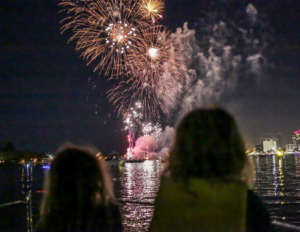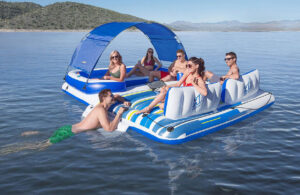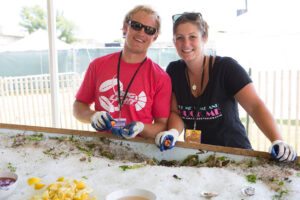WHEN THE PANDEMIC forced museums and other arts institutions to close, many of us suffered from culture withdrawal and longed for a time when we could gaze at the exquisite works by the likes of Rodin or Michelangelo.
While we wait for all our treasured art venues to reopen, Marinalife invites you to visit some rather unusual exhibits that are safe for social distancing and are simply extraordinary. And to the delight of boaters, they’re located beneath the waves.
Underwater sculpture gardens are placed on the sea floor, and when fish whirl around them and aquatic life attaches to the figures, the exhibits change and grow every day. The statues display universal human emotions, offer social commentary, present mythical or historic figures, or send messages about environmental conservation. All of them are worth a visit to experience the visionary concept of art helping nature.
Molinere Underwater Sculpture Park – Underwater Sculpture Gardens

Grenada, underwatersculpture.com
Lat/Long: 12.0834302 N, 61.7655757 W
Located in the Caribbean Sea just off the west coast of Grenada, British sculptor Jason deCaires Taylor has created a magnificent collection of submerged contemporary art. His 65 concrete statues are man-made wonders, cover about 800 square meters and have an ecological benefit of hosting a menagerie of sea life and colorful coral.
It opened to the public in May 2006 as the world’s first underwater sculpture park. The most famous work, Vicissitudes, portrays a ring of 26 children holding hands and facing out toward the water’s currents.
You can access the aquatic park from the main port of St. George’s (two miles north of the capital) or Grand Anse Bay on the west coast. View the works by snorkeling, scuba diving or riding in a glass bottom boat, as the garden lies in waters with a maximum depth of 12-14 meters.
Underwater Museum of Art (MUSA)
Cancún, Mexico, musamexico.org
Lat/Long: 21.0763 N, 86.8463 W
Concerns that tourist traffic, boat anchors and divers were damaging coral reefs in the waters off Cancún sparked the idea of creating MUSA and filling it with statues made of eco-safe, pH neutral marine concrete. The submerged museum opened in November 2010 and hosts about 500 sculptures, mostly crafted by Jason deCaires Taylor and five Mexican artists. During the past decade, nature has transformed the exhibits into a new living reef and an attraction for colorful coral, marine life and human visitors who swim among a dazzling array of figures.
MUSA is comprised of three galleries that welcome both certified and non-certified divers. The largest collection, Manchones Reef, holds 473 sculptures off the coast of Isla Mujeres. Waters from eight to 10 meters deep are for scuba diving only. The nine works of art in Punta Sam are found in shallower waters of three to four meters deep. Punta Nizuc, located at the southern tip of Cancún’s hotel zone, claims 33 sculptures in waters two to four meters deep that are for snorkeling tours.
Underwater Museum of Art (UMA) – Underwater Sculpture Gardens

Santa Rosa Beach, FL, umafl.org
Lat/Long: 30.18754 N, 086.0933722 W
The Gulf Coast waters near Walton County, Florida, were primarily flat and barren – until 2018 when a team of conservationists, arts advocates and sculptors deployed works of art to create an artificial reef, replenish the marine habitat and attract aquatic guests. As the first permanent underwater sculpture exhibit in the United States, this one-acre patch of seabed presents about 25 pieces of whimsical, nautical and abstract subjects such as a pineapple, revolving door, diamond ring, sea horses, octopus and magic lantern.
UMA is located almost a mile away from Grayton Beach’s white sand shoreline in the Gulf of Mexico. With sculptures positioned under 58 feet of water, this museum is best suited for certified scuba divers. The public space is free for visitors, but boaters should find the central location and back away from the park to anchor, so they don’t damage the art or reef.
Museo Atlántico

Lanzarote, Spain, underwatermuseumlanzarote.com/en
Lat/Long: 29.035000 N, -13.633000 W
Near the Atlantic Ocean’s Canary Islands, Museo Atlántico opened to the public in 2016. Its dual purpose as an artificial reef and submerged art exhibit entails 12 installations and 300 life-sized human figures designed by Jason deCaires Taylor. Each sculpture is constructed out of marine-grade cement to encourage the growth of new aquatic ecosystems and let the sea have a hand in their evolving beauty. Noteworthy installations include the Rubicon, a group of 35 people walking toward a massive wall. Several hybrid sculptures (half human, half cactus) depict the meshing of man and nature in perfect harmony. Deregulated is a playground where businessmen in suits play on a swing and a seesaw.
The underwater museum is located in a sheltered cove near Coloradas, Playa Blanca at a depth of 12-14 meters. Excursions and tours out of Playa Blanca, Puerto del Carmen, Costa Teguise and Fuerteventura are available for both beginner and licensed divers.
Solitary Sculptures Beneath the Waves – Underwater Sculpture Gardens
In addition to the magnificent underwater museums, you can also encounter impressive deep-sea statues standing alone across the Caribbean Sea and Atlantic Ocean. Here are a few that you’ll want to explore:
Amphitrite, Siren of Sunset Reef
Named after the wife of Poseidon, God of the Seas, this fetching bronze mermaid stands nine feet tall and weighs in at 600 pounds. Find her under 55 feet of water off Grand Cayman Island’s Sunset House Resort reef.

Ocean Atlantis
On the western coast of New Providence in Nassau, Bahamas, awaits the world’s biggest underwater statue. This massive, 60-ton statue portrays a Bahamian girl holding the weight of the seas upon her shoulders.
Christ of the Abyss
Under 25 feet of water in John Pennekamp Coral Reef State Park near Key Largo, FL, snorkelers can swim up to a nine feet tall bronze statue of Jesus with his arms outstretched toward the surface of the sea.
Virgin of the Lighthouse
The five feet tall bronze casting was submerged decades ago by Mexican fishermen in a location infamous for shipwrecks. The statue became a talisman for safe travels and is regularly visited by Isla Mujeres tourists and divers who seek good fortune.





